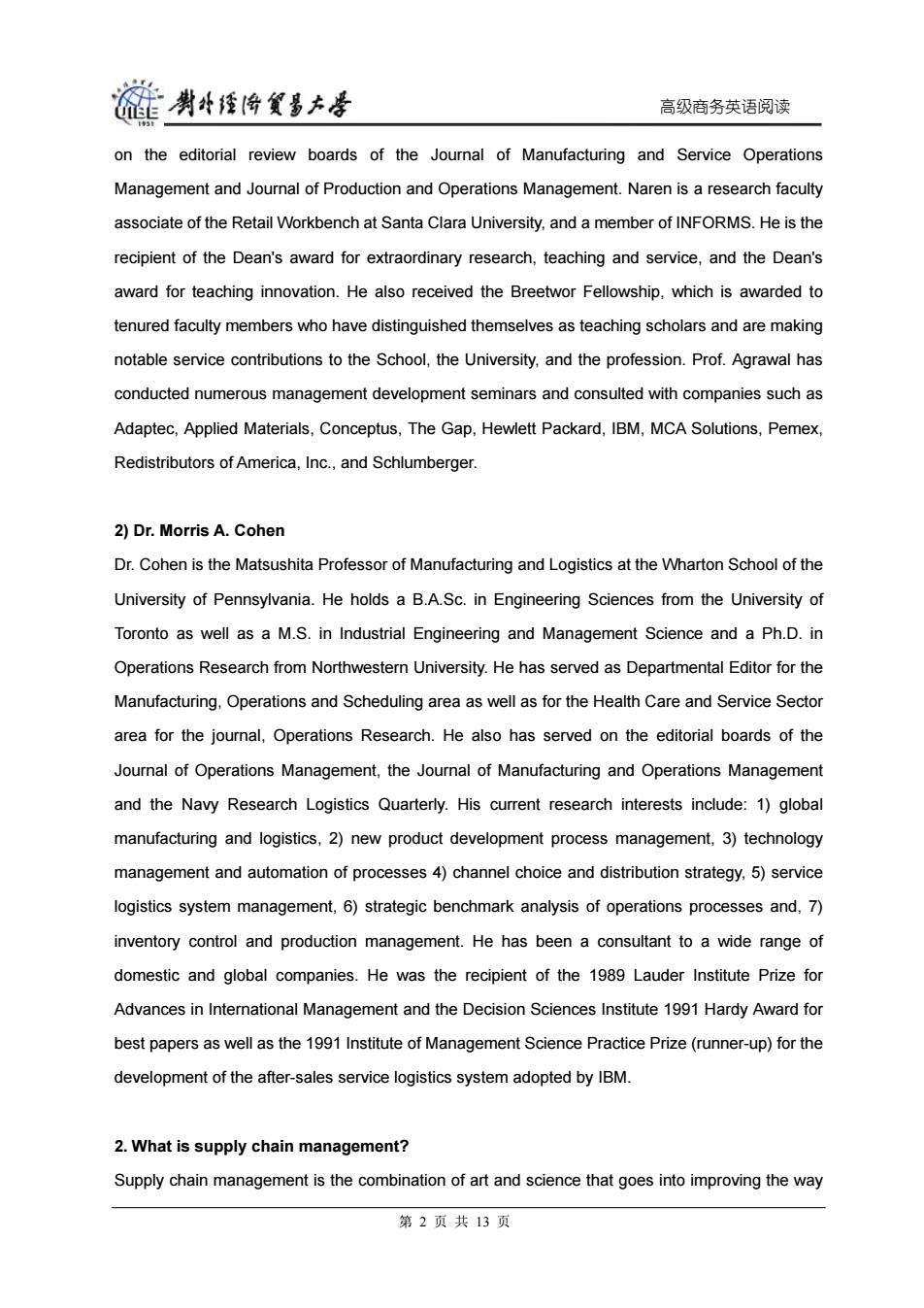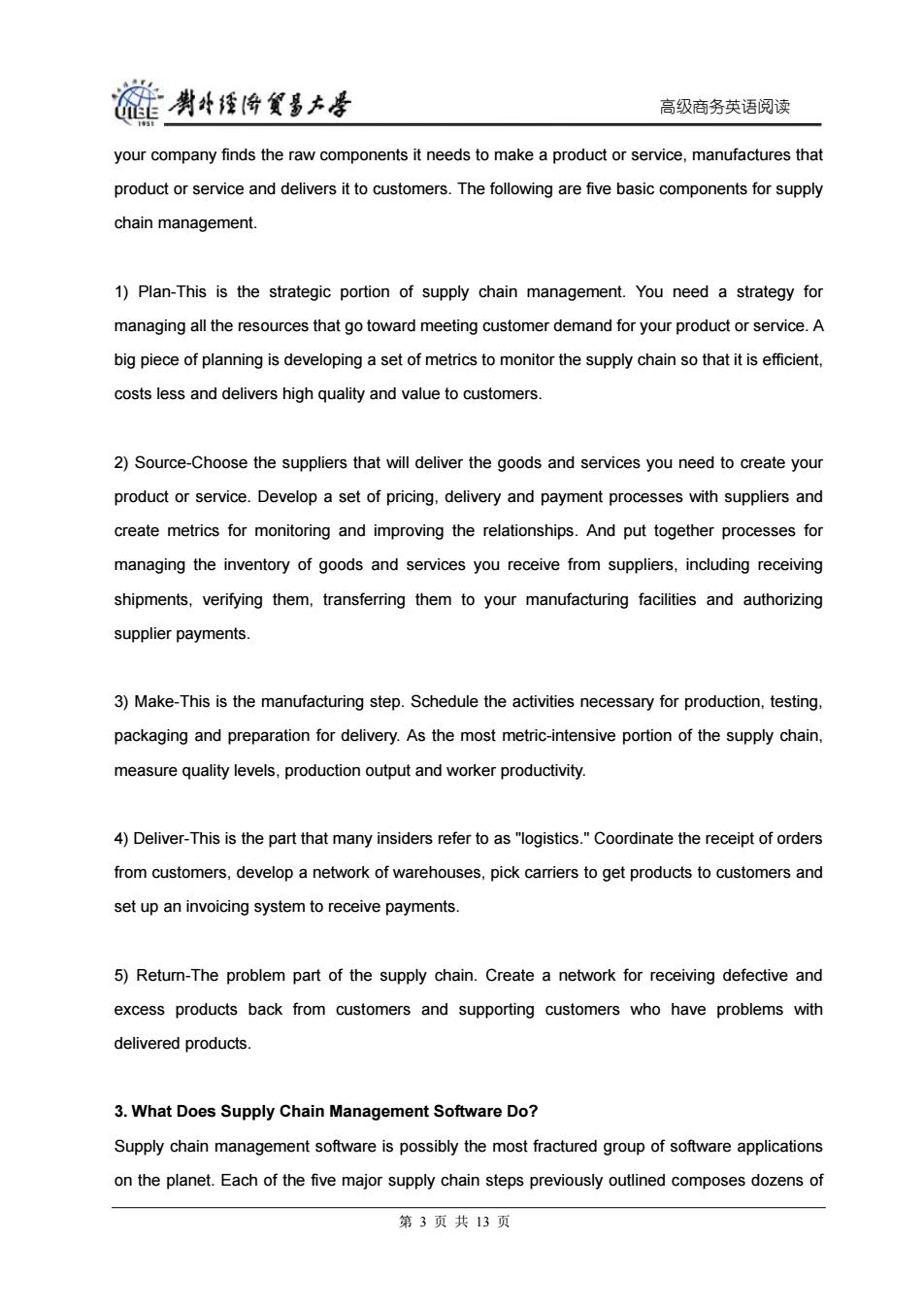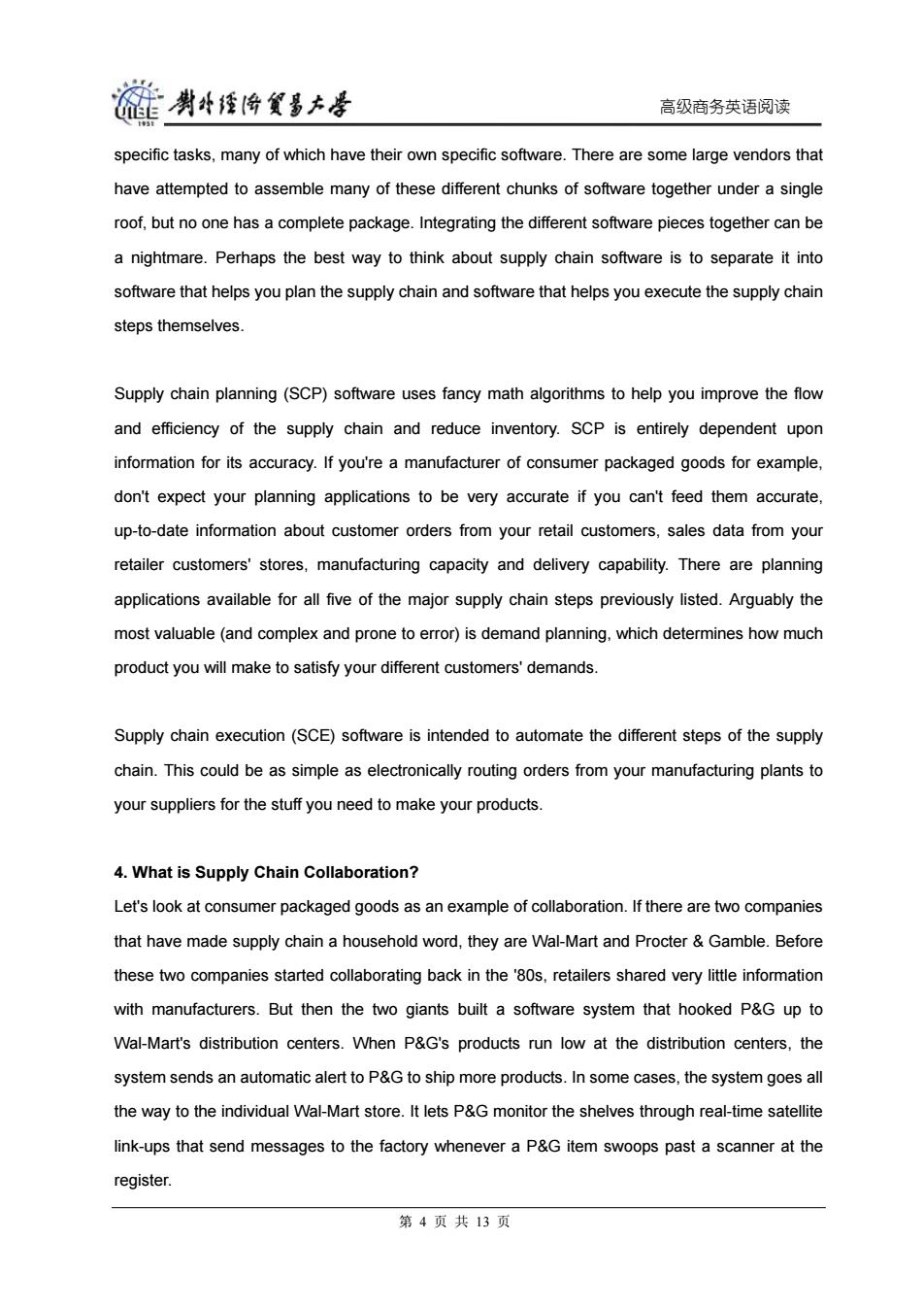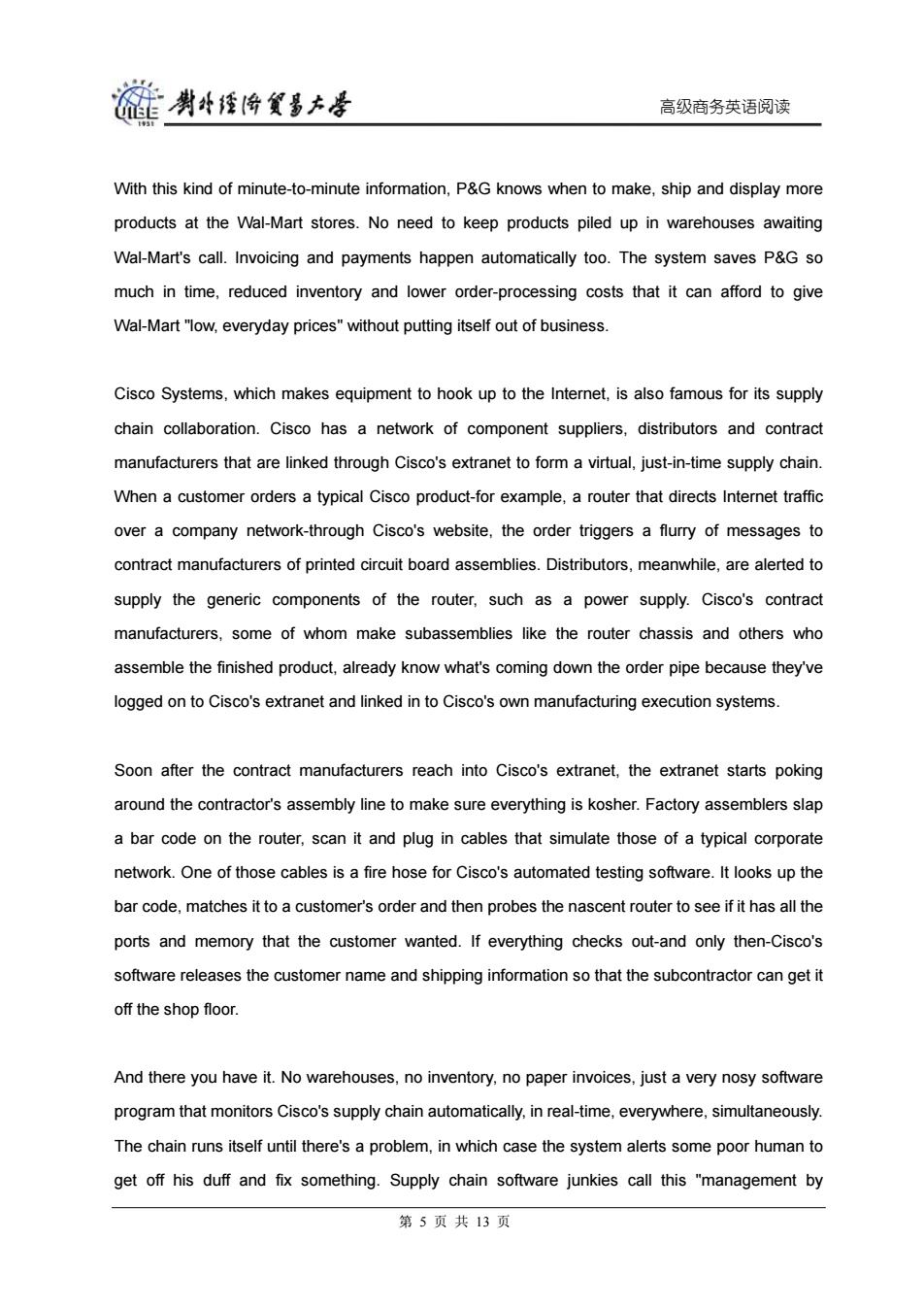
莲喇母矮将贸多大学 高级商务英语阅读 Chapter 12 Long Live the Revolution 1.教学目的 通过本文的学习,使学生了解到历史上两次技术革新带给商业模式的巨大革命,并使他们进一步 认识到新的管理模式下供应链结构的不同变化,并从经济和技术发展的进程启发学生对经济和管理 规模发展趋势的预测,并加深学生对我国改革开放历史意义的理解。本文涉及到许多经贸知识,如: 供应链、库存周转率、规模经济、产业调整等内容的基本概念学生也应掌握。另外,增强学生对上 述内容的英语术语表达也是本课的教学目的之一。 Ⅱ.教学计划 拟使用四课时完成本课内容。一课时介绍背景知识,两课时用于课文讲解及难点讨论,最后一 课时可就某一相关问题(如:供应链上出现的两次革命及技术革新对产业结构的影响等)展开讨论。 川.教学方法 以学生为中心,通过师生互动、各抒己见的方式理解和认识课文中涉及到的各类问题(也包括 语言方面的问题)。 IV.背景知识 1.About the author: 1)Dr.Narendra Agrawal Dr.Naren Agrawal is an associate professor in the Department of Operations Management Information Systems of Santa Clara University,and has been a visiting associate professor at the Wharton School of Business.He also worked as Systems Analyst with Tata Consultancy Services in Bombay,India.Prof.Agrawal teaches courses in supply chain management,operations management,computer based decision models,and manufacturing competitiveness in the MBA and executive MBA programs.His research interests include supply chain management,sourcing strategy,design and analysis of distribution systems,and manufacturing competitiveness.His research has been published in journals such as Operations Research,Manufacturing and Service Operations Management,Naval Research Logistics,IIE Transactions,and the Journal of Retailing He has also contributed chapters in a number of books on supply chain management.He serves 第1页共13页
高级商务英语阅读 Chapter 12 Long Live the Revolution I.教学目的 通过本文的学习,使学生了解到历史上两次技术革新带给商业模式的巨大革命,并使他们进一步 认识到新的管理模式下供应链结构的不同变化,并从经济和技术发展的进程启发学生对经济和管理 规模发展趋势的预测,并加深学生对我国改革开放历史意义的理解。本文涉及到许多经贸知识,如: 供应链、库存周转率、规模经济、产业调整等内容的基本概念学生也应掌握。另外,增强学生对上 述内容的英语术语表达也是本课的教学目的之一。 II.教学计划 拟使用四课时完成本课内容。一课时介绍背景知识,两课时用于课文讲解及难点讨论,最后一 课时可就某一相关问题(如:供应链上出现的两次革命及技术革新对产业结构的影响等)展开讨论。 III.教学方法 以学生为中心,通过师生互动、各抒己见的方式理解和认识课文中涉及到的各类问题(也包括 语言方面的问题)。 IV.背景知识 1. About the author: 1) Dr. Narendra Agrawal Dr. Naren Agrawal is an associate professor in the Department of Operations & Management Information Systems of Santa Clara University, and has been a visiting associate professor at the Wharton School of Business. He also worked as Systems Analyst with Tata Consultancy Services in Bombay, India. Prof. Agrawal teaches courses in supply chain management, operations management, computer based decision models, and manufacturing competitiveness in the MBA and executive MBA programs. His research interests include supply chain management, sourcing strategy, design and analysis of distribution systems, and manufacturing competitiveness. His research has been published in journals such as Operations Research, Manufacturing and Service Operations Management, Naval Research Logistics, IIE Transactions, and the Journal of Retailing. He has also contributed chapters in a number of books on supply chain management. He serves 第 1 页 共 13 页

链勇经份贸多大圣 高级商务英语阅读 on the editorial review boards of the Journal of Manufacturing and Service Operations Management and Journal of Production and Operations Management.Naren is a research faculty associate of the Retail Workbench at Santa Clara University,and a member of INFORMS.He is the recipient of the Dean's award for extraordinary research,teaching and service,and the Dean's award for teaching innovation.He also received the Breetwor Fellowship,which is awarded to tenured faculty members who have distinguished themselves as teaching scholars and are making notable service contributions to the School,the University,and the profession.Prof.Agrawal has conducted numerous management development seminars and consulted with companies such as Adaptec,Applied Materials,Conceptus,The Gap,Hewlett Packard,IBM,MCA Solutions,Pemex, Redistributors of America,Inc.,and Schlumberger. 2)Dr.Morris A.Cohen Dr.Cohen is the Matsushita Professor of Manufacturing and Logistics at the Wharton School of the University of Pennsylvania.He holds a B.A.Sc.in Engineering Sciences from the University of Toronto as well as a M.S.in Industrial Engineering and Management Science and a Ph.D.in Operations Research from Northwestern University.He has served as Departmental Editor for the Manufacturing,Operations and Scheduling area as well as for the Health Care and Service Sector area for the journal,Operations Research.He also has served on the editorial boards of the Journal of Operations Management,the Journal of Manufacturing and Operations Management and the Navy Research Logistics Quarterly.His current research interests include:1)global manufacturing and logistics,2)new product development process management,3)technology management and automation of processes 4)channel choice and distribution strategy,5)service logistics system management,6)strategic benchmark analysis of operations processes and,7) inventory control and production management.He has been a consultant to a wide range of domestic and global companies.He was the recipient of the 1989 Lauder Institute Prize for Advances in International Management and the Decision Sciences Institute 1991 Hardy Award for best papers as well as the 1991 Institute of Management Science Practice Prize(runner-up)for the development of the after-sales service logistics system adopted by IBM. 2.What is supply chain management? Supply chain management is the combination of art and science that goes into improving the way 第2页共13页
高级商务英语阅读 on the editorial review boards of the Journal of Manufacturing and Service Operations Management and Journal of Production and Operations Management. Naren is a research faculty associate of the Retail Workbench at Santa Clara University, and a member of INFORMS. He is the recipient of the Dean's award for extraordinary research, teaching and service, and the Dean's award for teaching innovation. He also received the Breetwor Fellowship, which is awarded to tenured faculty members who have distinguished themselves as teaching scholars and are making notable service contributions to the School, the University, and the profession. Prof. Agrawal has conducted numerous management development seminars and consulted with companies such as Adaptec, Applied Materials, Conceptus, The Gap, Hewlett Packard, IBM, MCA Solutions, Pemex, Redistributors of America, Inc., and Schlumberger. 2) Dr. Morris A. Cohen Dr. Cohen is the Matsushita Professor of Manufacturing and Logistics at the Wharton School of the University of Pennsylvania. He holds a B.A.Sc. in Engineering Sciences from the University of Toronto as well as a M.S. in Industrial Engineering and Management Science and a Ph.D. in Operations Research from Northwestern University. He has served as Departmental Editor for the Manufacturing, Operations and Scheduling area as well as for the Health Care and Service Sector area for the journal, Operations Research. He also has served on the editorial boards of the Journal of Operations Management, the Journal of Manufacturing and Operations Management and the Navy Research Logistics Quarterly. His current research interests include: 1) global manufacturing and logistics, 2) new product development process management, 3) technology management and automation of processes 4) channel choice and distribution strategy, 5) service logistics system management, 6) strategic benchmark analysis of operations processes and, 7) inventory control and production management. He has been a consultant to a wide range of domestic and global companies. He was the recipient of the 1989 Lauder Institute Prize for Advances in International Management and the Decision Sciences Institute 1991 Hardy Award for best papers as well as the 1991 Institute of Management Science Practice Prize (runner-up) for the development of the after-sales service logistics system adopted by IBM. 2. What is supply chain management? Supply chain management is the combination of art and science that goes into improving the way 第 2 页 共 13 页

醛肖经海食多大是 高级商务英语阅读 your company finds the raw components it needs to make a product or service,manufactures that product or service and delivers it to customers.The following are five basic components for supply chain management. 1)Plan-This is the strategic portion of supply chain management.You need a strategy for managing all the resources that go toward meeting customer demand for your product or service.A big piece of planning is developing a set of metrics to monitor the supply chain so that it is efficient, costs less and delivers high quality and value to customers. 2)Source-Choose the suppliers that will deliver the goods and services you need to create your product or service.Develop a set of pricing,delivery and payment processes with suppliers and create metrics for monitoring and improving the relationships.And put together processes for managing the inventory of goods and services you receive from suppliers,including receiving shipments,verifying them,transferring them to your manufacturing facilities and authorizing supplier payments. 3)Make-This is the manufacturing step.Schedule the activities necessary for production,testing, packaging and preparation for delivery.As the most metric-intensive portion of the supply chain, measure quality levels,production output and worker productivity. 4)Deliver-This is the part that many insiders refer to as"logistics."Coordinate the receipt of orders from customers,develop a network of warehouses,pick carriers to get products to customers and set up an invoicing system to receive payments. 5)Return-The problem part of the supply chain.Create a network for receiving defective and excess products back from customers and supporting customers who have problems with delivered products. 3.What Does Supply Chain Management Software Do? Supply chain management software is possibly the most fractured group of software applications on the planet.Each of the five major supply chain steps previously outlined composes dozens of 第3页共13页
高级商务英语阅读 your company finds the raw components it needs to make a product or service, manufactures that product or service and delivers it to customers. The following are five basic components for supply chain management. 1) Plan-This is the strategic portion of supply chain management. You need a strategy for managing all the resources that go toward meeting customer demand for your product or service. A big piece of planning is developing a set of metrics to monitor the supply chain so that it is efficient, costs less and delivers high quality and value to customers. 2) Source-Choose the suppliers that will deliver the goods and services you need to create your product or service. Develop a set of pricing, delivery and payment processes with suppliers and create metrics for monitoring and improving the relationships. And put together processes for managing the inventory of goods and services you receive from suppliers, including receiving shipments, verifying them, transferring them to your manufacturing facilities and authorizing supplier payments. 3) Make-This is the manufacturing step. Schedule the activities necessary for production, testing, packaging and preparation for delivery. As the most metric-intensive portion of the supply chain, measure quality levels, production output and worker productivity. 4) Deliver-This is the part that many insiders refer to as "logistics." Coordinate the receipt of orders from customers, develop a network of warehouses, pick carriers to get products to customers and set up an invoicing system to receive payments. 5) Return-The problem part of the supply chain. Create a network for receiving defective and excess products back from customers and supporting customers who have problems with delivered products. 3. What Does Supply Chain Management Software Do? Supply chain management software is possibly the most fractured group of software applications on the planet. Each of the five major supply chain steps previously outlined composes dozens of 第 3 页 共 13 页

链剥挂将发多大是 高级商务英语阅读 specific tasks,many of which have their own specific software.There are some large vendors that have attempted to assemble many of these different chunks of software together under a single roof,but no one has a complete package.Integrating the different software pieces together can be a nightmare.Perhaps the best way to think about supply chain software is to separate it into software that helps you plan the supply chain and software that helps you execute the supply chain steps themselves. Supply chain planning(SCP)software uses fancy math algorithms to help you improve the flow and efficiency of the supply chain and reduce inventory.SCP is entirely dependent upon information for its accuracy.If you're a manufacturer of consumer packaged goods for example, don't expect your planning applications to be very accurate if you can't feed them accurate, up-to-date information about customer orders from your retail customers,sales data from your retailer customers'stores,manufacturing capacity and delivery capability.There are planning applications available for all five of the major supply chain steps previously listed.Arguably the most valuable(and complex and prone to error)is demand planning,which determines how much product you will make to satisfy your different customers'demands. Supply chain execution(SCE)software is intended to automate the different steps of the supply chain.This could be as simple as electronically routing orders from your manufacturing plants to your suppliers for the stuff you need to make your products. 4.What is Supply Chain Collaboration? Let's look at consumer packaged goods as an example of collaboration.If there are two companies that have made supply chain a household word,they are Wal-Mart and Procter Gamble.Before these two companies started collaborating back in the '80s,retailers shared very little information with manufacturers.But then the two giants built a software system that hooked P&G up to Wal-Mart's distribution centers.When P&G's products run low at the distribution centers,the system sends an automatic alert to P&G to ship more products.In some cases,the system goes all the way to the individual Wal-Mart store.It lets P&G monitor the shelves through real-time satellite link-ups that send messages to the factory whenever a P&G item swoops past a scanner at the register. 第4页共13页
高级商务英语阅读 specific tasks, many of which have their own specific software. There are some large vendors that have attempted to assemble many of these different chunks of software together under a single roof, but no one has a complete package. Integrating the different software pieces together can be a nightmare. Perhaps the best way to think about supply chain software is to separate it into software that helps you plan the supply chain and software that helps you execute the supply chain steps themselves. Supply chain planning (SCP) software uses fancy math algorithms to help you improve the flow and efficiency of the supply chain and reduce inventory. SCP is entirely dependent upon information for its accuracy. If you're a manufacturer of consumer packaged goods for example, don't expect your planning applications to be very accurate if you can't feed them accurate, up-to-date information about customer orders from your retail customers, sales data from your retailer customers' stores, manufacturing capacity and delivery capability. There are planning applications available for all five of the major supply chain steps previously listed. Arguably the most valuable (and complex and prone to error) is demand planning, which determines how much product you will make to satisfy your different customers' demands. Supply chain execution (SCE) software is intended to automate the different steps of the supply chain. This could be as simple as electronically routing orders from your manufacturing plants to your suppliers for the stuff you need to make your products. 4. What is Supply Chain Collaboration? Let's look at consumer packaged goods as an example of collaboration. If there are two companies that have made supply chain a household word, they are Wal-Mart and Procter & Gamble. Before these two companies started collaborating back in the '80s, retailers shared very little information with manufacturers. But then the two giants built a software system that hooked P&G up to Wal-Mart's distribution centers. When P&G's products run low at the distribution centers, the system sends an automatic alert to P&G to ship more products. In some cases, the system goes all the way to the individual Wal-Mart store. It lets P&G monitor the shelves through real-time satellite link-ups that send messages to the factory whenever a P&G item swoops past a scanner at the register. 第 4 页 共 13 页

能男华经降贸多大星 高级商务英语阅读 With this kind of minute-to-minute information,P&G knows when to make,ship and display more products at the Wal-Mart stores.No need to keep products piled up in warehouses awaiting Wal-Mart's call.Invoicing and payments happen automatically too.The system saves P&G so much in time,reduced inventory and lower order-processing costs that it can afford to give Wal-Mart "low,everyday prices"without putting itself out of business. Cisco Systems,which makes equipment to hook up to the Internet,is also famous for its supply chain collaboration.Cisco has a network of component suppliers,distributors and contract manufacturers that are linked through Cisco's extranet to form a virtual,just-in-time supply chain. When a customer orders a typical Cisco product-for example,a router that directs Internet traffic over a company network-through Cisco's website,the order triggers a flurry of messages to contract manufacturers of printed circuit board assemblies.Distributors,meanwhile,are alerted to supply the generic components of the router,such as a power supply.Cisco's contract manufacturers,some of whom make subassemblies like the router chassis and others who assemble the finished product,already know what's coming down the order pipe because they've logged on to Cisco's extranet and linked in to Cisco's own manufacturing execution systems. Soon after the contract manufacturers reach into Cisco's extranet,the extranet starts poking around the contractor's assembly line to make sure everything is kosher.Factory assemblers slap a bar code on the router,scan it and plug in cables that simulate those of a typical corporate network.One of those cables is a fire hose for Cisco's automated testing software.It looks up the bar code,matches it to a customer's order and then probes the nascent router to see if it has all the ports and memory that the customer wanted.If everything checks out-and only then-Cisco's software releases the customer name and shipping information so that the subcontractor can get it off the shop floor. And there you have it.No warehouses,no inventory,no paper invoices,just a very nosy software program that monitors Cisco's supply chain automatically,in real-time,everywhere,simultaneously. The chain runs itself until there's a problem,in which case the system alerts some poor human to get off his duff and fix something.Supply chain software junkies call this "management by 第5页共13页
高级商务英语阅读 With this kind of minute-to-minute information, P&G knows when to make, ship and display more products at the Wal-Mart stores. No need to keep products piled up in warehouses awaiting Wal-Mart's call. Invoicing and payments happen automatically too. The system saves P&G so much in time, reduced inventory and lower order-processing costs that it can afford to give Wal-Mart "low, everyday prices" without putting itself out of business. Cisco Systems, which makes equipment to hook up to the Internet, is also famous for its supply chain collaboration. Cisco has a network of component suppliers, distributors and contract manufacturers that are linked through Cisco's extranet to form a virtual, just-in-time supply chain. When a customer orders a typical Cisco product-for example, a router that directs Internet traffic over a company network-through Cisco's website, the order triggers a flurry of messages to contract manufacturers of printed circuit board assemblies. Distributors, meanwhile, are alerted to supply the generic components of the router, such as a power supply. Cisco's contract manufacturers, some of whom make subassemblies like the router chassis and others who assemble the finished product, already know what's coming down the order pipe because they've logged on to Cisco's extranet and linked in to Cisco's own manufacturing execution systems. Soon after the contract manufacturers reach into Cisco's extranet, the extranet starts poking around the contractor's assembly line to make sure everything is kosher. Factory assemblers slap a bar code on the router, scan it and plug in cables that simulate those of a typical corporate network. One of those cables is a fire hose for Cisco's automated testing software. It looks up the bar code, matches it to a customer's order and then probes the nascent router to see if it has all the ports and memory that the customer wanted. If everything checks out-and only then-Cisco's software releases the customer name and shipping information so that the subcontractor can get it off the shop floor. And there you have it. No warehouses, no inventory, no paper invoices, just a very nosy software program that monitors Cisco's supply chain automatically, in real-time, everywhere, simultaneously. The chain runs itself until there's a problem, in which case the system alerts some poor human to get off his duff and fix something. Supply chain software junkies call this "management by 第 5 页 共 13 页